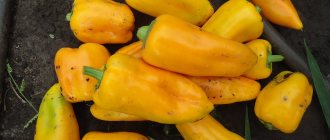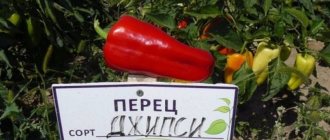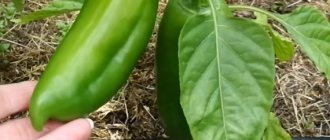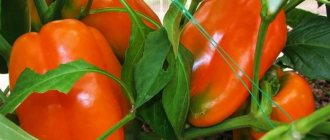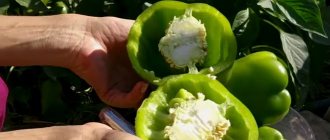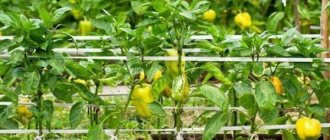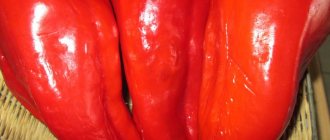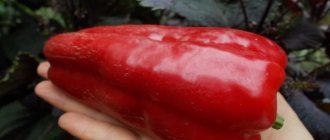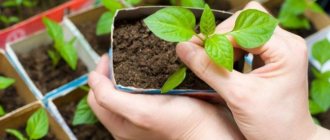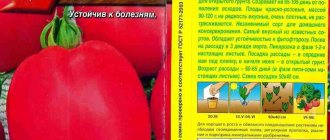Experienced gardeners know that sweet peppers love warm conditions. However, often excessive heat significantly reduces the yield of the crop. Short-term cooling also has an effect, so heat-resistant varieties that can withstand a short drop in air temperature are of particular value. Khalifa F1 is considered such crops. The article will provide the reader with a general description of the crop and bushes, the main qualities of the crop, and growing rules.
Characteristics of the variety
Each plant has certain characteristics that are taken into account when growing it. Knowing the description of the crop, the gardener has the opportunity to get an excellent harvest.
Khalif pepper is classified as an early ripening species. Fruiting begins after 90-95 days from the appearance of the first shoots.
Growing vegetables is possible both in greenhouse conditions and in open ground. The fruiting period varies in length.
Bush
The bush has the following characteristics:
- plant height is 50-90 cm;
- it is compact, but requires shaping.
Fruit
Description of fruits:
- vegetables are cube-shaped and dense in structure;
- the color of the fruit at the stage of technical ripeness is milky white, light green, biological - deep red;
- the pulp is juicy, without the bitterness characteristic of peppers;
- vegetables are shelf-stable, can be stored well, and can withstand long-term transportation without losing their taste and marketability;
- The fruits are universal in use: they can be used fresh or for preparing winter preparations.
Productivity
Under favorable conditions, the yield of Khalif f1 pepper pleases gardeners with high rates: from 1 m² per season you can harvest more than a bucket of selected vegetables. Large, fleshy fruits weigh 100-200 g. It is better to collect them at the moment of technical maturity, which will not delay the formation of subsequent ovaries.
Advantages and disadvantages
The benefits of pepper include the following:
- the hybrid plant forms ovaries well in almost any growing conditions;
- the variety has increased resistance to diseases such as tobacco mosaic;
- under favorable conditions, the plant is capable of producing the highest yield for such crops.
Among the main disadvantages are a weak root system and the need to tie up and form a bush.
Description and characteristics of sweet pepper Khalif F1, reviews, photos
An early productive pepper hybrid from Japanese breeders from Sakata. Recommended for cultivation in open ground, film tunnels and greenhouses. The period from germination to the beginning of ripening is 90-95 days.
The hybrid sets fruit well in various growing conditions. Characterized by long-term fruiting.
The bush is compact, about 60 cm high. The formation of this pepper consists of removing side shoots and leaves up to the first fork.
Basic qualities of fruits
The fruits are cuboid-prismatic in shape, strong, light green in technical ripeness, red in biological ripeness, fleshy, weighing 180-210 grams, excellent taste without bitterness. Wall thickness 7-9 mm. This pepper has a universal purpose - suitable for both fresh consumption and canning and home cooking.
The hybrid is highly resistant to tobacco mosaic virus.
The productivity of Khalif pepper is high.
Growing seedlings
Planting seedlings
The Khalif f1 pepper variety is recommended to be grown in seedlings due to the fact that the growing season of the plant is long. This method allows you to plant stronger seedlings in a permanent place, which can quickly adapt to new conditions.
Conditions
In order for the seedlings to be healthy and strong, a number of growing conditions must be observed:
- the optimal temperature for seed germination should be 25-28 °C;
- It is advisable to pre-disinfect the containers for sowing and the soil in which the seeds will be placed by steaming (water with a hot solution of potassium permanganate, disinfect with hydrogen peroxide or another antiseptic) or calcination (keep the soil for 30-40 minutes in a hot oven);
- Before planting the seedlings, it should be fertilized at least 2 times with organic fertilizers.
Planting dates and technology
Vegetable seeds should be sown 50-70 days before transplanting the seedlings to a permanent location. Sowing begins in March-April.
Technology:
- It is recommended to soak the seed for 15-30 minutes before sowing. in a weak solution of an antiseptic (potassium permanganate, hydrogen peroxide, etc.) with the addition of a growth stimulator (Kornevin, Epin, etc.);
- After disinfection, the seeds are dried; if desired, they can be germinated. To do this, they are placed in a damp cloth and placed in a warm place for 1-2 days. During this time, the material must not be allowed to dry out, so it is necessary to regularly moisten the seeds with warm water using a spray bottle;
- the seed is placed in a common container or separate containers in moist soil at a depth of 1-1.5 cm. After this, the plantings are covered with film material and placed in a warm, dark place until the first shoots appear. During this period, it is advisable to ventilate the seedlings daily;
- After the young shoots appear, the film is removed from the container, and the seedlings are placed in a well-lit, warm place.
Seedling care
Young and fragile seedlings require increased attention. It is necessary to regularly water them with warm, settled water, avoiding waterlogging or drying out of the soil. If the sprouts look weakened and lifeless, it is suggested to fertilize the soil with a liquid fertilizer containing organic matter.
If the crop was sown in a common box, after 2-3 true leaves appear on the seedlings, it is picked (transplanted) into separate containers with a volume of 0.3-0.5 liters. The root system of young peppers is sensitive to damage, so picking should be done extremely carefully.
After transplanting, the pepper may stop growing. During this stressful period for crops, you can spray them with Epin or another substance that stimulates their growth.
Description and characteristics of the variety
The Khalif F1 pepper has earned its popularity. Judging by reviews from gardeners, the hybrid combines high consumer and commercial qualities with ease of care, resistance to adverse factors and diseases.
The State Register recommends Khalif for planting in the southern regions in open beds. But the first wave of fruits ripens well in vegetable gardens in the central zone, and a full-fledged harvest can be obtained in film tunnels and greenhouses in all regions.
Description of the bush
The Khalif hybrid forms a bush of medium height, reaching a height of 50-70 cm in open beds, and up to 90 cm in protected ground. It is strong, medium-leafed, with light green, slightly wrinkled plates.
Fruit characteristics
Even Khalifa fruits collected from one bush can have different shapes:
- conical, with a sharp nose, characteristic of Bulgarian varieties;
- cuboid or prism-shaped, with a depressed apex, like Dutch hybrids.
This is rarely indicated in descriptions of the variety, but is clearly visible in the photo. The peppers do not look different in size; regardless of their shape, they remain beautiful, with a glossy, even surface.
The color of the fruit depends on the degree of ripeness. Technically they are milky white, then gradually change color to orange, and at the stage of biological maturity they become light red.
The size of Khalifa F1 fruits can be adjusted by forming a bush:
- If you allow the plant to develop freely, only exposing the stem to the first fork, as in Bulgarian varieties, there will be a lot of peppers. But the size is 80-100 g. This is convenient for whole-fruit canning or pickling.
- When formed into 2-3 trunks and constantly pinching the tips of the shoots after the ovary appears, the hybrid will produce large fruits. Their weight can exceed not only the stated 180 g, but also 200 g.
The wall of the Khalif pepper is 6-7 mm, the number of chambers is 3-4. The taste is sweet even at the stage of technical ripeness, without bitterness; upon reaching the biological level, the amount of sugars increases, the aroma becomes strong and rich.
Khalifa's marketability, transportability and keeping quality are good. The purpose is universal. The harvest, harvested at the stage of technical ripeness, ripens well during storage.
Ripening time and yield
Hybrid Khalif – early. From the moment the seeds peck until the fruit turns milky white, 90-95 days pass; until biological ripeness you will have to wait 120-130 days.
You can eat this pepper without waiting for consumer maturity. The taste and aroma will be very good, but not as rich as red fruits.
The yield is high, in the beds it reaches 7-10 kg per square meter. m, in greenhouses - up to 14 kg. But only if the pepper bears fruit all season. For open ground, this is only possible in the southern regions.
The hybrid ripens in waves - first the peppers on the lower tiers begin to color, while the upper ones are just beginning to fill. Therefore, in a cool climate, all the ovaries do not have time to ripen.
Transplanting seedlings
Sweet and tasty peppers in fertilized soil
Sweet peppers of the Khalif variety grow well in light, loose, well-fertilized soil. In the fall, organic and potassium-phosphorus fertilizers are first applied to it. In spring, it is advisable to enrich the soil with ammonium nitrate (30-40 g per 1 m2).
5-7 days before transplanting seedlings, it is recommended to disinfect the soil using a solution of copper sulfate (1 tablespoon per 10 liters of water).
Seedlings are transplanted into open ground when the soil has warmed up well and the risk of night cold snaps is minimal (late spring-early summer). For greenhouse cultivation, peppers can be planted in early April.
Planting scheme for young peppers Khalif f1: 3-4 bushes are placed per 1 m². It is necessary to place the seedling in the hole at the same depth at which it grew in the nursery, without exposing the root system and without hiding the root collar in the soil. Immediately after transplanting, it is advisable to water and attach the crop to a support installed nearby.
Peppers are prone to cross-pollination, so planting several varieties side by side is not recommended.
It is advisable to plant this vegetable after legumes, early cabbage, herbs or onions.
Advantages and disadvantages
Farmers plant Khalif F1 pepper in plots because its advantages include the following:
- The culture is not susceptible to tobacco mosaic virus.
- The fruits can be stored for 2 - 3 months after collection.
- Plants are not afraid of hot weather and can produce crops during short periods of cold weather.
- Pepper is transported without loss of quality.
- The fruits are suitable for many culinary ideas.
- The bushes are low and do not require special shaping or staking.
- With good care, the hybrid has a yield of more than 7 kg/m2.
Among the disadvantages, farmers note the inability to grow peppers from their own seeds. To obtain a harvest, the gardener needs to purchase planting material annually.
Care
Proper care of peppers will give you the opportunity to get the maximum yield of quality vegetables. This ensures that the crop will have good immunity and be less susceptible to diseases and pest attacks typical of these vegetables.
Watering
Soil moisture should be regular but moderate. Excess moisture can lead to bacterial diseases of the root system of the crop, and its lack will weaken the vegetable - the leaves will turn yellow and crumble, and the yield will be significantly lower.
Watering is carried out in the morning or evening with warm rain or settled water. It is advisable to alternate it with loosening and weeding. This will retain moisture in the soil for a longer time, and air access to the rhizome will improve. Some vegetable growers mulch the soil with straw.
Feeding
Peppers require constant care
It is recommended to fertilize pepper at least 3-4 times during the season. Systematic monitoring of the condition of plants will allow you to quickly determine what substance the soil lacks.
In the phase of appearance of 1-2 true leaves, the first feeding is carried out using the following solution: 2-3 g of superphosphate, 0.5 g of nitrate, 1-2 g of potassium are added to 1 liter of water. After 2 weeks, fertilizing is repeated, increasing the amount of mineral fertilizers up to 2 times.
Popular among gardeners are feeding peppers with nettle infusion and a solution of chicken manure (1:10). It is advisable to alternate them with mineral supplements (1 tablespoon of nitrophoska per 10 liters of water).
It is necessary to regularly apply potassium-phosphorus fertilizers to the soil, which affect the number of ovaries on the crop and the quality of vegetables.
Pruning and shaping the bush
The Khalif pepper bush is described as compact, but this does not relieve the gardener from the need for regular pinching (pruning) of the crop. Its essence is to remove side shoots, which accelerate their growth in wet weather. It is undesirable to carry out pinching in the heat: the presence of additional foliage on the bush protects the soil from rapid evaporation of moisture.
The lowest, longest shoots should be pruned; you should try to achieve maximum illumination of the bush with sunlight. It is also worth removing unnecessary branches of the culture. Stepping is carried out once every 7-10 days, more often if necessary.
The Khalif variety requires the formation of a bush and its subsequent tying. When the crop reaches a height of 20-25 cm, the top, which is located on the main stem, is removed. Of the remaining strong shoots, it is recommended to leave no more than 3-4 stepsons.
To speed up the ripening of vegetables, gardeners advise once again additionally removing the top of the bush plant after half the fruiting period.
Disease and pest control
Among the diseases to which the vegetable is exposed are gray and white rot, downy mildew, late blight, black leg, etc. Khalif has increased immunity to a disease characteristic of peppers, such as tobacco mosaic.
It is much easier to take preventive measures that will prevent the occurrence of a disease than to cure an already infected crop. As a preventive measure against diseases, the following treatments are carried out:
- 0.05% potassium permanganate solution;
- "Previkur";
- 4% copper oxychloride solution;
- Bordeaux mixture;
- charcoal, etc.
To prevent diseases, it is imperative to take into account the crop planting scheme, do not over-moisten the soil, and regularly ventilate greenhouses. A systematic examination of vegetables will make it possible to notice the disease in the first stages of its development.
Among the pests that can negatively affect the yield of pepper are aphids, spider mites, slugs, Colorado potato beetles, etc. They are regularly treated with special fungicides, combining them with traditional methods (infusions of garlic, onion, dandelion, celandine, etc.).
Diseases and pests of the variety
Khalif withstands the attacks of tobacco mosaic - the variety is immune to this disease.
But, like other pepper varieties, it can be affected by the following diseases, which must be combated immediately:
- Black leg . The disease is recognized by the brown color of the bottom of the stems and rotting of the changed areas, which leads to the death of the bush. Blackleg develops if the crop is planted too densely or suffers from excessive moisture. To eliminate the disease, it is advisable to water the pepper bushes with a manganese solution (at the initial stage), loosen the soil, and hill up the root collar of the plant. You can reduce soil moisture by sprinkling it with sand or ash.
- Late blight , which is caused by the spread of fungal spores. Brown spots, like blackleg, quickly affect the entire plant, including the fruits. Therefore, there is no point in slowing down the fight. Affected bushes need to be treated with Gamaira solution (you can water - 1 tablet / 5 l of water, or spray - 2 tablets / 1 l of water), Alirina-B (watering: 2 tablets / 5 l of water; spraying: 2 tablets / 1 l of water) , Fitosporina-M (10 g / 5 l of water, spray).
- Blossom rot , which affects the fruits of the crop: black spots appear on their tips, which quickly spread throughout the entire fruit. The appearance of the disease is caused by insufficient watering, as well as if the plant needs calcium supplements and is oversaturated with nitrogen. Peppers that have already suffered from the disease cannot be revived; they must be destroyed, after which the bushes must be treated with a 0.2% solution of calcium nitrate.
- White rot is a disease caused by fungi that occupy the lower part of the stem (closer to the root). The affected part of the stem becomes covered with a white coating, sclerotia (compacted black accumulations of fungal spores) form inside it, and soon the entire bush becomes intoxicated. Plants that have succumbed to the attacks of white rot cannot be saved: they must be destroyed as soon as possible. Since the disease is caused by high humidity and low air temperature, the fight against it consists of watering the bushes with warm water.
- Fusarium , which is manifested by yellowing and curling of Khalifa leaves caused by fungal attacks. The source of the disease is seeds or soil infected with the fungus. Methods for curing this disease are not yet known, so the affected bushes need to be destroyed (in any case, they will die in 10–20 days). You can try treatment with a 0.2% solution of Topsin-M or Fundazol, but this will only slow down the development of the disease.
Pests that can attack Khalif pepper include:
- Colorado potato beetle , whose attacks are repelled with a solution of the drug Commander (1 ml / bucket of water). Before spraying, it is recommended to collect insects from the bushes. If the fight is not started in a timely manner, then the voracious beetles, together with their larvae, will leave only stems from the pepper bushes.
- Slugs . They cause harm to greenery and fruits: they gnaw them and cause rotting. Spraying with a solution of Strela insecticide (50 g / bucket of water) will help eliminate such uninvited guests.
- Whitefly , against which the drug Fosbecid is effective (the solution is prepared strictly according to the instructions).
- Aphids , the danger of which lies in the fact that it literally sucks all the juices out of the plant, as a result of which it can die. Aphids multiply quickly and occupy all the bushes, so when they appear, you should immediately treat the pepper with a solution of Karbofos or Keltan, strictly observing the proportions specified in the instructions. You can also spray the bushes with a homemade preparation of ash (1 tbsp.), liquid mil (1 tbsp.) and water (10 l).
- Mole cricket , which is not averse to eating pepper leaves. The smell of kerosene, which is sprayed in places where it accumulates, will help to ward off the uninvited guest.
Harvest and storage
Depending on the region and the conditions under which the Khalif variety is grown, fruiting begins in mid-to-late July and continues until the first frost. Vegetables in a state of biological and technical ripeness are suitable for harvesting. In the second case, the fruits should be set aside to ripen.
Harvesting is carried out every 6-8 days using a sharp knife. This will prevent the pepper or its stem from being damaged, which could result in a shorter shelf life.
Vegetables are stored in wooden boxes in a cool and ventilated place. Regular inspection is required to remove damaged fruit from the common container. With proper storage of Khalif sweet pepper, it can retain its qualities for up to 2 months.
Advantages and disadvantages of the variety
The advantages include high yield, unpretentiousness, immunity to diseases and pests. Peppers are distinguished by their commercial appearance; Kalif is grown for personal consumption and for sale. Vegetables are stored and transported for a long time, without losing their beneficial qualities and taste. This hybrid is planted outdoors, in greenhouses or greenhouses.
Interesting! Sweet Calif is valued for its versatility in use. Red glossy fruits are used to prepare vegetable stews, stuffed dishes, snacks and salads. The moderately juicy pulp goes harmoniously with meat and fish dishes; the peppers are used fresh and pickled in jars for the winter.
The only negative is that the seedlings do not tolerate picking. This can be avoided: the seeds are immediately planted in large containers, in which the pepper seedlings develop before planting in open ground.
Reviews from gardeners
Those who have been involved in growing the variety note the high taste qualities of the fruits, their good keeping quality and transportability. Vegetable growers recommend carefully monitoring the external condition of the plant and carrying out all the necessary fertilizing.
Particular attention should be paid to the formation of the bush and its garter. Abundant yields can cause crop branches to break off or become damaged. It is advisable to tie not only large stems to the support, but also weaker branches.
Khalif is an excellent option for a novice gardener. By following the basic growing rules that apply to all hybrid plants, you can enjoy a rich harvest of healthy and tasty vegetables.
Reviews
Pepper Khalif F1 receives the following reviews:
- Growing this variety brought a lot of good impressions - summer resident Vladislav.
- The crop bears fruit for a long time and is well stored - Marina from Izhevsk.
- I didn't like the hybrid. The bushes grow slowly, the pepper is large, but very watery - Peter from the Moscow region.
- The pulp is sugary, very sweet. Fresh pepper tastes amazing - Elizaveta from Krasnodar.
- You can plant 3 - 4 bushes and enjoy the harvest all summer - summer resident Veronica.
Khalif F1 pepper is a variety that deserves the attention of farmers. With sufficient care it shows good productivity. The fruits of the hybrid have an attractive taste and can be used in many culinary dishes.
